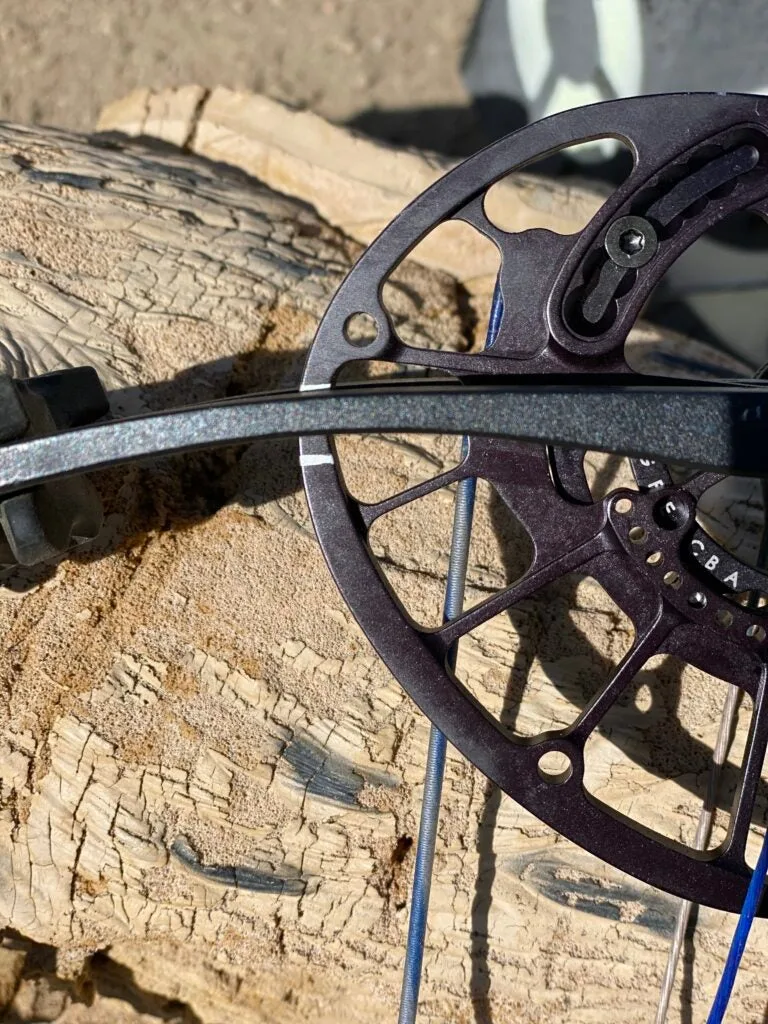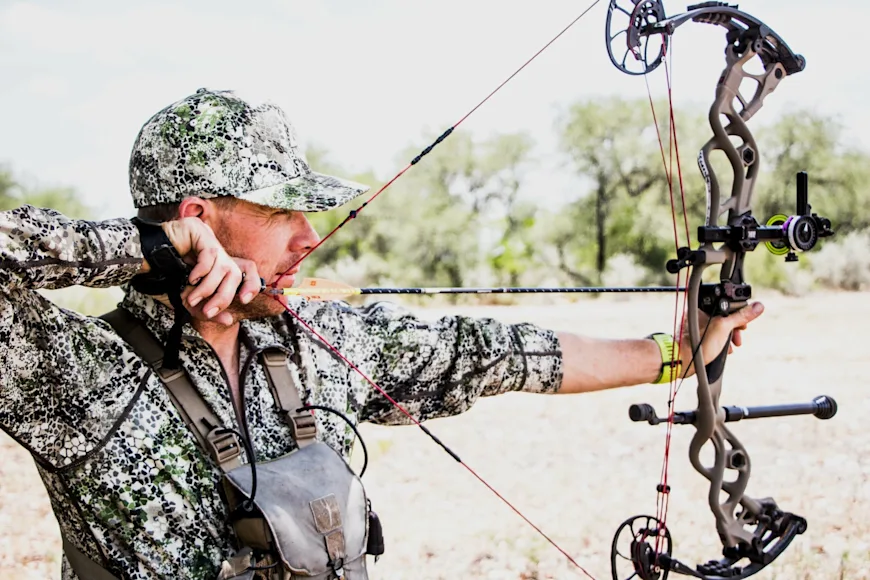_We may earn revenue from the products available on this page and participate in affiliate programs. Learn more ›
_
Through the school of hard knocks and a lot of time spent with bow-tuning wizards, I have learned how to tune a compound bow so thoroughly and meticulously that it will fire arrows straight and true for as far as you care to shoot them. This is called micro-tuning, and it’s often touted by top shooters. It’s a handy skill to have, but the buzz around micro-tuning has created a big misconception. It has left everyday hunters and casual shooters with the idea that bow tuning requires serious technical expertise, plus a pinch of magic.
That’s just not the case.
If your goal is simply to tattoo a whitetail inside 40 yards, which accounts for more than half of all bowhunters worldwide, you can learn how to tune a compound bow
yourself. It’s actually pretty easy. Here’s your step-by-step guide to getting a good, basic tune that will have you stacking arrows in the bullseye at normal hunting ranges.
How to Tune a Compound Bow, Step 1: Attach the Arrow Rest

Secure you bow in a vise, attach the rest, and tie in a D-loop for the nocking point. Jace Bauserman
It’s fitting, in a way, that the first step is attaching a rest to the bow riser. You can’t get very far tuning a bow without it, of course, but also when it comes to a simple, basic tune for hunting, it’s small adjustments to the rest, more than anything, that will fix the problems you run into.
So, first, use a vice to secure your bow in a level, vertical position. (There are many good bow vises out there, and they are not very expensive.) Now simply follow the manufacturer’s instructions to attach the rest to the bow riser’s Berger hole (or holes), or to the face of the riser, depending on the type of rest you have. If you have a whisker biscuit
or hostage-type rest, you’re done for now. If you have a fall-away rest, connect the rest cord to the downward buss cable or to a limb, again, following the manufacturer’s instructions. Don’t worry about getting the rest perfectly positioned at this point, just get it correctly mounted. Now nock an arrow, and use an arrow level—these are widely available and cost only a few bucks-to determine you nocking point. Then tie in a D-loop
.
Tuning a Compound Bow, Step 2: Time a Fall-Away Rest

The two tuning marks—the white lines on the lower right of the site—should line up as the bow break over. QAD Ultrarest
If you have a drop-away rest
, use the tuning marks (see owners manual) to set the rest’s speed. Have a partner watch the marks as you come to full draw. Typically, the tuning marks need to line up just as the bow breaks over and transitions into let-off. If your rest has no tuning marks, have your helper note the position of the launcher arm as you draw the bow. The arm should hit the vertical position just as the bow breaks over. If it doesn’t, simply tighten or loosen the cord, as needed.
Tuning a Compound Bow Step 3: Adjust the Center Shot

Measure a nocked arrow off the front and back of the riser to find the center shot. Or just eyeball it. Dave Hurteau
Now you want to set the center shot. In simple terms, center shot is the perfect alignment of the arrow rest to the bowstring’s nocking point. Read your bow’s manual for an initial center-shot setting. The most common location is between center of the arrow shelf (measured off the riser) and 3/16 inch to the left of center for a right-handed shooter. Another option is to measure a nocked arrow off both the front and back of the riser, moving the rest left or right until both of those two measurements are the same. All of that said, you can easily just eyeball it; knock an arrow and move the rest left or right until, from and overhead view, the arrow appears to extend through the center of the riser (as a long stabilizer would). That’s how I do it, and then I work out the kinks later while paper tuning. If you have a laser or a bow square
, they work well too for finding the center shot.
Bow Tuning Step 4: Fix Any Fletch Contact

If unwanted arrow-to-rest contact persists, use spray powder to better diagnose the problem. Dave Hurteau
If you are using a fall-away rest, the next step is to stand close to a foam target and fire an arrow. Listen carefully for any whap, bang, or clang. This indicates severe arrow-to-rest contact. Also, pay attention to the arrow’s position in the target. While bag targets
will lie, a good foam target will show how the arrow entered. If adjustments are needed, speed the rest up or slow it down by adjusting the cable. You can also manipulate the rest up, down, left, or right if needed.
If struggles persist, use foot spray powder. Spray the inside of the launcher, the arrow shelf, and the last 7 inches of the arrow. Shoot the painted arrow into the target, remove it carefully, and look for marks. Make adjustments as needed until it comes out clean.
Bow Tuning Step 5: Stretch the String
Now that you can send arrows downrange without any bangs or clangs, do some shooting to get comfortable with the grip and tighten up your shooting form with the bow. This does two things. First, you want to have good form when paper tuning a bow, and this shooting session acts as a warm up. Second, it stretches the strings and cables out a bit, which will help your bow stay in tune after you’re done.
Bow Tuning Step 6: Paper Tune

The author uses a window frame for paper tuning. The left side shows a perfect tear. Jace Bauserman
You can build a paper tuner out of anything. I cover an old window frame with typing paper, stapled around the outside. Set your paper tuner up with a target behind it. Be sure to leave enough room between the paper and the target for the arrow to pass entirely through. Stand 3 yards from the paper, make sure your grip is good, relax, and send an arrow. Now observe the tear. Chances are good the tear won’t be perfect. Don’t panic. The next part is easy.
Use an arrow tear reference chart
to identify what type of tear you have. With the tear diagnosed, tweak the rest. About 90 percent of all tear issues can be remedied by slightly moving your arrow rest up, down, left, or right. For instance, a nock-left tear can usually be rectified by moving the rest to the right, and vice versa. With any left or right rest movement, you are effectively changing the center shot, which is why eyeballing works just fine during the beginning stages. Got a nock-high tear? No problem. Move the rest up or move your nocking point down. For a nock low tear, drop the rest or raise the nocking point. If you take your time and micro-adjust your rest, common tuning issues will be eliminated.
If you have a slightly off tear that you can’t get rid of, don’t fret. Some bows shoot better that way. Go ahead and sight in your bow. If it is stacking arrows in the kill zone out to 60 yards, don’t give it another thought. Also, there’s no need to check the tune of your bow often. As long as they bow is shooting well, you’re good. Don’t overthink it.
How to Tune a Compound Bow, Final Step: Walk-Back Tune

For walk-back tuning, you want your arrows to run along the vertical line of tape. Jace Bauserman
Once everything looks good, the final step for how to tune a compound bow is to walk-back tune. Get a large foam target and using a simple plumb bob for reference, run blue or orange painters’ tape in a vertical line from the top of the target to the bottom. Then, toward the top of the target, run another line of tape horizontally across. On a calm day, stand at a distance of 20 yards and shoot a single arrow at the exact point where the two pieces of tape intersect. If your paper tune is good and your arrow hits left or right of your point of aim, manipulate your sight. Repeat this process out to 40 yards, using the same 20-yard pin. The goal is for each arrow to be in a line going down the vertical piece of tape.
If, however, your arrows string progressively to one side or the other as they move down the tape, you’ll need to make a very slight left or right tweak to the arrow rest. Then shoot again and tweak as needed until they run right down the tape in a straight line.

Once your bow is tuned, mark the cams where it meets the limb for future reference. Jace Bauserman
After the tuning process is complete, use a silver Sharpie to mark the position of your top and bottom cams where each meets the top and bottom limb. These marks make great reference points if you have to re-tune down the line.
There. You’re done. You’ve learned how to tune a compound bow, and hitting the mark on your next buck won’t be an issue—as long as you keep together.






